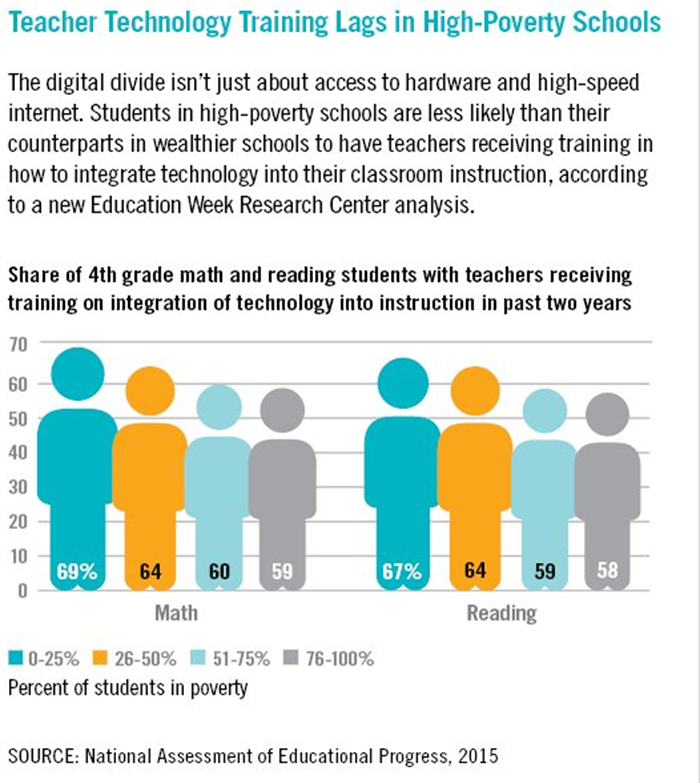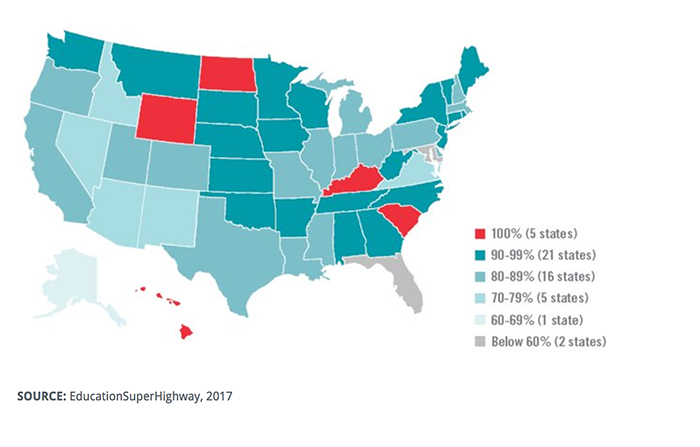As Connectivity Improves, The Digital Divide Persists in Teacher Tech Preparation
While it may seem like more and more schools are embracing technology in the classroom, Education Week’s 20th annual Technology Counts survey has found that schools still aren’t quite reaching the full potential of technology in the classroom, largely because of digital divide issues, particularly around teacher training.
“Technology is everywhere today but a digital divide among schools has emerged because quality and equity issues are huge and they need to be confronted,” says Kevin Bushweller, executive project editor of Technology Counts, in a press release.
Other disparities found by the survey include access to and adoption of both tools and the infrastructure — high-speed internet connections — needed.
SIGN UP: Get more news from the EdTech newsletter in your inbox every two weeks!
Lower Income Schools Fall Behind in Teacher Training for Tech
The percentage of fourth-grade teachers who have received training in how to integrate computers into instruction has remained stagnant since 2009, with lower income schools consistently less likely than their counterparts to have this kind of professional development, Education Week reports.
“Over the past decade, the ‘digital divide’ in America’s public schools has shifted,” reports Education Week. “Classrooms in nearly every corner of the country have been flooded with devices and software. High-speed internet connectivity has expanded dramatically. Undoubtedly, there are still big disparities in the technologies available to the haves and the have-nots.”
Recent Education Week Research Center analysis found a near 10 percent disparity between high- and low-income teachers and their access to technology training.

SOURCE: "Poor Students Face Digital Divide in How Teachers Learn to Use Tech," Education Week
In states like Pennsylvania, districts with huge income disparities are close neighbors. South Fayette Township School District — with just 13 percent of students indicated as poor — has a vision of how to use technology to teach complex topics like computational thinking. Education Week reports that the district’s intermediate school even has a dedicated science, technology, engineering, arts and math (STEAM) instructor to help other educators with lesson plans using technology.
The article also looks at Sto-Rox High School, in a district just 10 miles from South Fayette, where the only evident tech use is smartphones that students bring in. Experts tell Education Week that it is no surprise that schools like Sto-Rox find it hard to spend limited resources on educating teachers on how to incorporate technology.
“When a lot of things are broken, how do you prioritize and fix what’s most important?” says Innovative Educator Consulting Network CEO Naomi Harm.
High-Speed Internet Connections Are Increasing
Even with access to technology, some K–12 schools find themselves unable to fully embrace classroom innovation because of poor internet connectivity. That seems to be steadily changing.
At Sto-Rox High School, a small number of Chromebooks are on hand for classroom use, but they were untouched for a year because of spotty Wi-Fi access. That has since changed.
Data from 2016 shows that 88 percent of school districts in the U.S. are meeting the Federal Communications Commission’s minimum internet connectivity of 100kbps per student. That number has massively improved from 30 percent just three years prior. In fact, the recent numbers show only Florida and Maryland indicated that fewer than 60 percent of their districts met the FCC target.

SOURCE: "Data Dive: Devices and Software Flooding Into Classrooms," Education Week
Many schools have made these changes because of E-Rate funds, but experts have also indicated that new FCC leadership might make it more difficult for rural school districts to roll out better connectivity.
Shortly after FCC Chairman Ajit Pai took office, he sent inquiries to 100 schools districts that are pursuing building fiber-optic networks using federal funds. Also, Pai’s suggested per-pupil payment system has some officials worrying that rural schools may not get enough funds to do the work they need.
“We’d have to look at what the [per-pupil] cap would be, but it could make connections even more difficult,” says Brian Mitchell, Nevada’s director of the office of science, innovation and technology.









